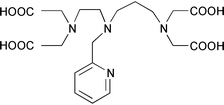The protonation constants of four poly(aminocarboxylates), N′-pyridylmethyl (TTDA-PY), N′-2-hydroxypropyl (TTDA-HP), N′-2-hydroxy-1-phenylethyl (TTDA-H1P) and N′-2-hydroxy-2-phenylethyl (TTDA-H2P) derivatives of TTDA (3,6,10-tri(carboxymethyl)-3,6,10-triazadodecanedioic acid), and the stability constants of their complexes formed with Ca2+, Zn2+, Cu2+, La3+, Ce3+, Nd3+, Sm3+, Gd3+, Dy3+, Ho3+, Yb3+ and Lu3+ were determined by potentiometric methods at 25.0 ± 0.1 °C and 0.10 mol dm−3 ionic strength in Me4NNO3. The stability of the Gd(III) complexes
follows the order TTDA-PY > TTDA-H2P ≊ TTDA-HP ≊ TTDA-H1P. The thermodynamic resistance of the gadolinium(III) complexes, at the plasma concentration used in clinical applications, towards demetallation in the presence of important components of blood plasma, such as Ca(II), Zn(II) and Cu(II), has been evaluated. The observed water proton relaxivity values of [Gd(TTDA-PY)]−, [Gd(TTDA-HP)]−, [Gd(TTDA-H1P)]− and [Gd(TTDA-H2P)]− became constant with respect to pH changes over the range of 4–10, 6–10, 6–10 and 6–10, respectively. 17O NMR shifts showed that the [Dy(TTDA-PY)]−, [Dy(TTDA-HP)]−, [Dy(TTDA-H1P)]− and [Dy(TTDA-H2P)]− complexes at pH 6.30 and 4.30 had 0.9 and 0.9; 2.2 and 3.4; 2.0
and 3.5; 1.8 and 3.0 inner-sphere water molecules, respectively. Water proton spin–lattice relaxation rates for gadolinium(III) complexes were also consistent with the number of inner-sphere water molecules. The EPR transverse electronic relaxation rate and 17O NMR transverse relaxation time were thoroughly investigated and the results obtained were compared with that previously reported for the other gadolinium(III) complex, [Gd(DTPA)(H2O)]2−. Short exchange lifetime values were obtained for the [Gd(TTDA)(H2O)]2−, [Gd(TTDA-PY)(H2O)]−, [Gd(TTDA-HP)(H2O)2]−, [Gd(TTDA-H1P)(H2O)2]− and [Gd(TTDA-H2P)(H2O)2]− complexes. Their water-exchange rates are about 24–45 times faster than that for the [Gd(DTPA)(H2O)]2−
complex, which suggested that the longer backbone of the multidentate ligand may be pulled tightly into the first coordination sphere, resulting in high steric constraints at the water binding site.


 Please wait while we load your content...
Please wait while we load your content...